- Future Students
- Current Students
- Faculty/Staff

- Current Students Hub

Doctoral handbook

You are here
- Dissertation Content
A doctoral dissertation makes an original contribution to knowledge, as defined in a discipline or an interdisciplinary domain and addresses a significant researchable problem. Not all problems are researchable and not all are significant. Problems that can be solved by a mere descriptive exercise are not appropriate for the PhD dissertation. Acceptable problems are those that:
- pose a puzzle to the field at a theoretical, methodological, or policy level;
- make analytical demands for solution, rather than mere cataloging or descriptive demands; and
- can yield to a reasonable research methodology.
The doctoral dissertation advisor, reading committee, and oral exam committee provide further guidance and details with regard to dissertation content and format. General formatting and submission guidelines are published by the University Registrar. The American Psychological Association (APA) publication guidelines normally apply to GSE doctoral dissertations, but is not required if the advisor and relevant committees determine that an alternative, and academically acceptable, protocol is more appropriate.
Published Papers and Multiple Authorship
The inclusion of published papers in a dissertation is the prerogative of the major department. Where published papers or ready-for-publication papers are included, the following criteria must be met:
1. There must be an introductory chapter that integrates the general theme of the research and the relationship between the chapters. The introduction may also include a review of the literature relevant to the dissertation topic that does not appear in the chapters.
2. Multiple authorship of a published paper should be addressed by clearly designating, in an introduction, the role that the dissertation author had in the research and production of the published paper. The student must have a major contribution to the research and writing of papers included in the dissertation.
3. There must be adequate referencing of where individual papers have been published.
4. Written permission must be obtained for all copyrighted materials; letters of permission must be uploaded electronically in PDF form when submitting the dissertation. Please see the following website for more information on the use of copyrighted materials: http://library.stanford.edu/using/copyright-reminder .
5. The submitted material must be in a form that is legible and reproducible as required by these specifications. The Office of the University Registrar will approve a dissertation if there are no deviations from the normal specifications that would prevent proper dissemination and utilization of the dissertation. If the published material does not correspond to these standards, it will be necessary for the student to reformat that portion of the dissertation.
6. Multiple authorship has implications with respect to copyright and public release of the material. Be sure to discuss copyright clearance and embargo options with your co-authors and your advisor well in advance of preparing your thesis for submission.
- Printer-friendly version
Handbook Contents
- Timetable for the Doctoral Degree
- Degree Requirements
- Registration or Enrollment for Milestone Completion
- The Graduate Study Program
- Student Virtual and Teleconference Participation in Hearings
- First Year (3rd Quarter) Review
- Second Year (6th Quarter) Review
- Committee Composition for First- and Second-Year Reviews
- Advancement to Candidacy
- Academic Program Revision
- Dissertation Proposal
- Dissertation Reading Committee
- University Oral Examination
- Submitting the Dissertation
- Registration and Student Statuses
- Graduate Financial Support
- GSE Courses
- Curriculum Studies and Teacher Education (CTE)
- Developmental and Psychological Sciences (DAPS)
- Learning Sciences and Technology Design (LSTD)
- Race, Inequality, and Language in Education (RILE)
- Social Sciences, Humanities, and Interdisciplinary Policy Studies in Education (SHIPS)
- Contact Information
- Stanford University Honor Code
- Stanford University Fundamental Standard
- Doctoral Programs Degree Progress Checklist
- GSE Open Access Policies
PhD students, please contact

MA POLS and MA/PP students, please contact

EDS, ICE/IEPA, Individually Designed, LDT, MA/JD, MA/MBA students, please contact

Stanford Graduate School of Education
482 Galvez Mall Stanford, CA 94305-3096 Tel: (650) 723-2109
- Contact Admissions
- GSE Leadership
- Site Feedback
- Web Accessibility
- Career Resources
- Faculty Open Positions
- Explore Courses
- Academic Calendar
- Office of the Registrar
- Cubberley Library
- StanfordWho
- StanfordYou
Improving lives through learning

- Stanford Home
- Maps & Directions
- Search Stanford
- Emergency Info
- Terms of Use
- Non-Discrimination
- Accessibility
© Stanford University , Stanford , California 94305 .
/images/cornell/logo35pt_cornell_white.svg" alt="content dissertation"> Cornell University --> Graduate School
Guide to writing your thesis/dissertation, definition of dissertation and thesis.
The dissertation or thesis is a scholarly treatise that substantiates a specific point of view as a result of original research that is conducted by students during their graduate study. At Cornell, the thesis is a requirement for the receipt of the M.A. and M.S. degrees and some professional master’s degrees. The dissertation is a requirement of the Ph.D. degree.
Formatting Requirement and Standards
The Graduate School sets the minimum format for your thesis or dissertation, while you, your special committee, and your advisor/chair decide upon the content and length. Grammar, punctuation, spelling, and other mechanical issues are your sole responsibility. Generally, the thesis and dissertation should conform to the standards of leading academic journals in your field. The Graduate School does not monitor the thesis or dissertation for mechanics, content, or style.
“Papers Option” Dissertation or Thesis
A “papers option” is available only to students in certain fields, which are listed on the Fields Permitting the Use of Papers Option page , or by approved petition. If you choose the papers option, your dissertation or thesis is organized as a series of relatively independent chapters or papers that you have submitted or will be submitting to journals in the field. You must be the only author or the first author of the papers to be used in the dissertation. The papers-option dissertation or thesis must meet all format and submission requirements, and a singular referencing convention must be used throughout.
ProQuest Electronic Submissions
The dissertation and thesis become permanent records of your original research, and in the case of doctoral research, the Graduate School requires publication of the dissertation and abstract in its original form. All Cornell master’s theses and doctoral dissertations require an electronic submission through ProQuest, which fills orders for paper or digital copies of the thesis and dissertation and makes a digital version available online via their subscription database, ProQuest Dissertations & Theses . For master’s theses, only the abstract is available. ProQuest provides worldwide distribution of your work from the master copy. You retain control over your dissertation and are free to grant publishing rights as you see fit. The formatting requirements contained in this guide meet all ProQuest specifications.
Copies of Dissertation and Thesis
Copies of Ph.D. dissertations and master’s theses are also uploaded in PDF format to the Cornell Library Repository, eCommons . A print copy of each master’s thesis and doctoral dissertation is submitted to Cornell University Library by ProQuest.
Have a language expert improve your writing
Run a free plagiarism check in 10 minutes, automatically generate references for free.
- Knowledge Base
- Dissertation
What Is a Dissertation? | 5 Essential Questions to Get Started
Published on 26 March 2020 by Jack Caulfield . Revised on 5 May 2022.
A dissertation is a large research project undertaken at the end of a degree. It involves in-depth consideration of a problem or question chosen by the student. It is usually the largest (and final) piece of written work produced during a degree.
The length and structure of a dissertation vary widely depending on the level and field of study. However, there are some key questions that can help you understand the requirements and get started on your dissertation project.
Instantly correct all language mistakes in your text
Be assured that you'll submit flawless writing. Upload your document to correct all your mistakes.

Table of contents
When and why do you have to write a dissertation, who will supervise your dissertation, what type of research will you do, how should your dissertation be structured, what formatting and referencing rules do you have to follow, frequently asked questions about dissertations.
A dissertation, sometimes called a thesis, comes at the end of an undergraduate or postgraduate degree. It is a larger project than the other essays you’ve written, requiring a higher word count and a greater depth of research.
You’ll generally work on your dissertation during the final year of your degree, over a longer period than you would take for a standard essay . For example, the dissertation might be your main focus for the last six months of your degree.
Why is the dissertation important?
The dissertation is a test of your capacity for independent research. You are given a lot of autonomy in writing your dissertation: you come up with your own ideas, conduct your own research, and write and structure the text by yourself.
This means that it is an important preparation for your future, whether you continue in academia or not: it teaches you to manage your own time, generate original ideas, and work independently.
The only proofreading tool specialized in correcting academic writing
The academic proofreading tool has been trained on 1000s of academic texts and by native English editors. Making it the most accurate and reliable proofreading tool for students.

Correct my document today
During the planning and writing of your dissertation, you’ll work with a supervisor from your department. The supervisor’s job is to give you feedback and advice throughout the process.
The dissertation supervisor is often assigned by the department, but you might be allowed to indicate preferences or approach potential supervisors. If so, try to pick someone who is familiar with your chosen topic, whom you get along with on a personal level, and whose feedback you’ve found useful in the past.
How will your supervisor help you?
Your supervisor is there to guide you through the dissertation project, but you’re still working independently. They can give feedback on your ideas, but not come up with ideas for you.
You may need to take the initiative to request an initial meeting with your supervisor. Then you can plan out your future meetings and set reasonable deadlines for things like completion of data collection, a structure outline, a first chapter, a first draft, and so on.
Make sure to prepare in advance for your meetings. Formulate your ideas as fully as you can, and determine where exactly you’re having difficulties so you can ask your supervisor for specific advice.
Your approach to your dissertation will vary depending on your field of study. The first thing to consider is whether you will do empirical research , which involves collecting original data, or non-empirical research , which involves analysing sources.
Empirical dissertations (sciences)
An empirical dissertation focuses on collecting and analysing original data. You’ll usually write this type of dissertation if you are studying a subject in the sciences or social sciences.
- What are airline workers’ attitudes towards the challenges posed for their industry by climate change?
- How effective is cognitive behavioural therapy in treating depression in young adults?
- What are the short-term health effects of switching from smoking cigarettes to e-cigarettes?
There are many different empirical research methods you can use to answer these questions – for example, experiments , observations, surveys , and interviews.
When doing empirical research, you need to consider things like the variables you will investigate, the reliability and validity of your measurements, and your sampling method . The aim is to produce robust, reproducible scientific knowledge.
Non-empirical dissertations (arts and humanities)
A non-empirical dissertation works with existing research or other texts, presenting original analysis, critique and argumentation, but no original data. This approach is typical of arts and humanities subjects.
- What attitudes did commentators in the British press take towards the French Revolution in 1789–1792?
- How do the themes of gender and inheritance intersect in Shakespeare’s Macbeth ?
- How did Plato’s Republic and Thomas More’s Utopia influence nineteenth century utopian socialist thought?
The first steps in this type of dissertation are to decide on your topic and begin collecting your primary and secondary sources .
Primary sources are the direct objects of your research. They give you first-hand evidence about your subject. Examples of primary sources include novels, artworks and historical documents.
Secondary sources provide information that informs your analysis. They describe, interpret, or evaluate information from primary sources. For example, you might consider previous analyses of the novel or author you are working on, or theoretical texts that you plan to apply to your primary sources.
Dissertations are divided into chapters and sections. Empirical dissertations usually follow a standard structure, while non-empirical dissertations are more flexible.
Structure of an empirical dissertation
Empirical dissertations generally include these chapters:
- Introduction : An explanation of your topic and the research question(s) you want to answer.
- Literature review : A survey and evaluation of previous research on your topic.
- Methodology : An explanation of how you collected and analysed your data.
- Results : A brief description of what you found.
- Discussion : Interpretation of what these results reveal.
- Conclusion : Answers to your research question(s) and summary of what your findings contribute to knowledge in your field.
Sometimes the order or naming of chapters might be slightly different, but all of the above information must be included in order to produce thorough, valid scientific research.
Other dissertation structures
If your dissertation doesn’t involve data collection, your structure is more flexible. You can think of it like an extended essay – the text should be logically organised in a way that serves your argument:
- Introduction: An explanation of your topic and the question(s) you want to answer.
- Main body: The development of your analysis, usually divided into 2–4 chapters.
- Conclusion: Answers to your research question(s) and summary of what your analysis contributes to knowledge in your field.
The chapters of the main body can be organised around different themes, time periods, or texts. Below you can see some example structures for dissertations in different subjects.
- Political philosophy
This example, on the topic of the British press’s coverage of the French Revolution, shows how you might structure each chapter around a specific theme.

This example, on the topic of Plato’s and More’s influences on utopian socialist thought, shows a different approach to dividing the chapters by theme.

This example, a master’s dissertation on the topic of how writers respond to persecution, shows how you can also use section headings within each chapter. Each of the three chapters deals with a specific text, while the sections are organised thematically.

Prevent plagiarism, run a free check.
Like other academic texts, it’s important that your dissertation follows the formatting guidelines set out by your university. You can lose marks unnecessarily over mistakes, so it’s worth taking the time to get all these elements right.
Formatting guidelines concern things like:
- line spacing
- page numbers
- punctuation
- title pages
- presentation of tables and figures
If you’re unsure about the formatting requirements, check with your supervisor or department. You can lose marks unnecessarily over mistakes, so it’s worth taking the time to get all these elements right.
How will you reference your sources?
Referencing means properly listing the sources you cite and refer to in your dissertation, so that the reader can find them. This avoids plagiarism by acknowledging where you’ve used the work of others.
Keep track of everything you read as you prepare your dissertation. The key information to note down for a reference is:
- The publication date
- Page numbers for the parts you refer to (especially when using direct quotes)
Different referencing styles each have their own specific rules for how to reference. The most commonly used styles in UK universities are listed below.
| & | An author–date citation in brackets in the text… | …corresponding to an entry in the alphabetised reference list at the end. |
|---|---|---|
| A superscript or bracketed reference number in the text… | …corresponding to an entry in the numbered reference list at the end. | |
| A footnote in the text that gives full source information… | …and an alphabetised bibliography at the end listing all sources. |
You can use the free APA Reference Generator to automatically create and store your references.
APA Reference Generator
The words ‘ dissertation ’ and ‘thesis’ both refer to a large written research project undertaken to complete a degree, but they are used differently depending on the country:
- In the UK, you write a dissertation at the end of a bachelor’s or master’s degree, and you write a thesis to complete a PhD.
- In the US, it’s the other way around: you may write a thesis at the end of a bachelor’s or master’s degree, and you write a dissertation to complete a PhD.
The main difference is in terms of scale – a dissertation is usually much longer than the other essays you complete during your degree.
Another key difference is that you are given much more independence when working on a dissertation. You choose your own dissertation topic , and you have to conduct the research and write the dissertation yourself (with some assistance from your supervisor).
Dissertation word counts vary widely across different fields, institutions, and levels of education:
- An undergraduate dissertation is typically 8,000–15,000 words
- A master’s dissertation is typically 12,000–50,000 words
- A PhD thesis is typically book-length: 70,000–100,000 words
However, none of these are strict guidelines – your word count may be lower or higher than the numbers stated here. Always check the guidelines provided by your university to determine how long your own dissertation should be.
At the bachelor’s and master’s levels, the dissertation is usually the main focus of your final year. You might work on it (alongside other classes) for the entirety of the final year, or for the last six months. This includes formulating an idea, doing the research, and writing up.
A PhD thesis takes a longer time, as the thesis is the main focus of the degree. A PhD thesis might be being formulated and worked on for the whole four years of the degree program. The writing process alone can take around 18 months.
Cite this Scribbr article
If you want to cite this source, you can copy and paste the citation or click the ‘Cite this Scribbr article’ button to automatically add the citation to our free Reference Generator.
Caulfield, J. (2022, May 05). What Is a Dissertation? | 5 Essential Questions to Get Started. Scribbr. Retrieved 9 September 2024, from https://www.scribbr.co.uk/thesis-dissertation/what-is-a-dissertation/
Is this article helpful?

Jack Caulfield
Other students also liked, how to choose a dissertation topic | 8 steps to follow, how to write a dissertation proposal | a step-by-step guide, what is a literature review | guide, template, & examples.
- How it works

How to Create the Best Table of Contents for a Dissertation
Published by Owen Ingram at August 12th, 2021 , Revised On September 20, 2023
“A table of contents is an essential part of any article, book, proceedings, essay , and paper with plenty of information. It requires providing the reader’s guidance about the position of the content.”
When preparing a dissertation , you may cram as much information into it as appropriate. The dissertation may be an extremely well-written one with a lot of valuable information to offer. Still, all that information could become perplexing if the reader cannot easily find the information.
The length of dissertations usually varies from a few pages to a few hundred pages, making it very difficult to find information that you may be after.
Instead of skimming through every page of the dissertation, there is a need for a guideline that directs the reader to the correct section of the dissertation and, more importantly, the correct page in the section.
Also read: The List of Figures and Tables in the Dissertation .
What is the Table of Contents in the Dissertation?
The table of contents is the section of a dissertation that guides each section of the dissertation paper’s contents.
Depending on the detail level in a table of contents, the most useful headings are listed to provide the reader concerning which page the said information may be found.
The table of contents is essentially a list found at the beginning of a dissertation , which contains names of the chapters, section titles and/or very brief descriptions, and page numbers indicated for each.
This allows the reader to look at the table of contents to locate the information needed from the dissertation. Having an effective table of contents is key to providing a seamless reading experience to the reader.
Here in this article, we will uncover every piece of information you need to know to write the dissertation’s abstract.
This article helps the readers on how to create the best table of contents for the dissertation. An important thing to note is that this guide discusses creating a table of contents in Microsoft Word.
Looking for dissertation help?
Researchprospect to the rescue then.
We have expert writers on our team who are skilled at helping students with dissertations across a variety of disciplines. Guaranteeing 100% satisfaction!

Styles for Dissertation Table of Contents
Making an effective table of contents starts with identifying headings and designating styles to those headings.
Using heading styles to format your headings can save a lot of time by automatically converting their formatting to the defined style and serves as a tool to identify the heading and its level, used later when creating a thesis table of contents .
Each heading style already has predefined sizes, fonts, colours, spacing, etc. but can be changed as per the user’s requirements. This also helps once all headings have been created and you intend to change the style of a certain type of heading.
All that is needed to change the style of a type of heading is automatically reflected on all headings that use the style.
Below is how the styles menu looks like;

To allocate a style to a heading, first select a heading and then click on one of the styles in the ‘Styles’ menu. Doing so converts the selected heading to the style that is selected in the Styles menu.
You can style a similar heading level in the same style by selecting each heading and then clicking on the style in the Style menu.
It is important to note that it greatly helps and saves time if you allocate styles systematically, i.e., you allocate the style as you write.
The styles are not limited to headings only but can be used for paragraphs and by selecting the whole paragraph and applying a style to it.
Changing Appearance of Pre-Defined Styles
To change the appearance of a style to one that suits you,
- You would need to right-click on one of the styles to open a drop-down menu.
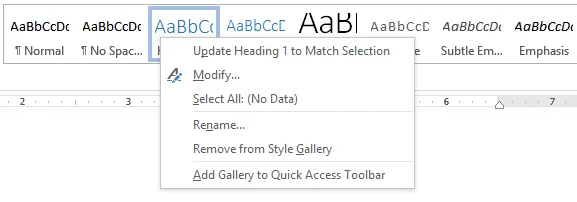
- Select ‘Modify’ from the menu. This would display a window with various formatting and appearance options. You can select the most appropriate ones and click ‘OK.’ The change that you made to the style reflects on all headings or paragraphs that use this style.
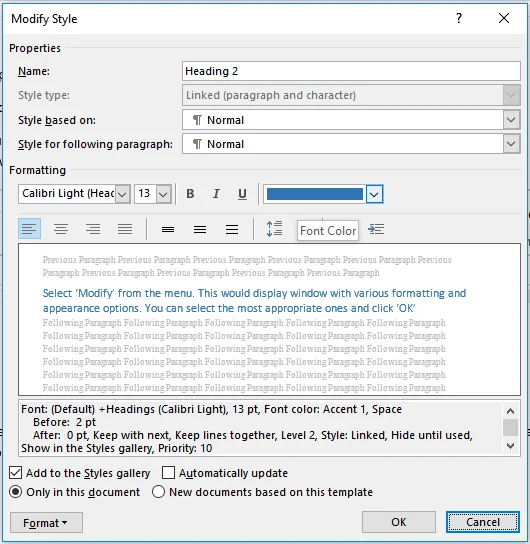
Further changes can be made to headings, but using styles is an important step for creating the table of contents for the thesis. Once this step is completed, you can continue to create a thesis table of contents.
Also Read: What is Appendix in Dissertation?
Things to Consider when Making APA Style Table of Contents
- The pages before the body of the dissertation, known as the ‘Prefatory Pages,’ should not have page numbers on them but should be numbered in the Roman Numerals instead as (i, ii, iii…).
- Table of Contents and the Abstract pages are not to contain any numbers.
- The remaining pages would carry the standard page numbers (1,2,3…).
- The section titles and page numbers in the dissertation table of contents should have dotted lines between them.
- All the Prefatory pages, Sections, Chapter Titles, Headings, Sub Headings, Reference Sections, and Appendices should be listed in the contents’ thesis table. If there are a limited number of Tables or Figures, they may be listed in the dissertation’s table contents.
- If there are many figures, tables, symbols, or abbreviations, a List of Tables, List of Figures , List of Symbols, and List of Abbreviations should be made for easy navigation. These lists, however, should not be listed in the thesis table of contents.
- The thesis/dissertation must be divided into sections even if it is not divided into chapters, with all sections being listed in the table of contents for the thesis.
Generating Dissertation Table of Contents
First, to generate the Table of Contents, start by entering a blank page after the pages you need the table of contents to follow.
- To do so, click on the bottom of the page you want before the Table of Contents.
- Open the ‘Insert’ tab and select ‘Page Break’.
- This will create a page between the top and bottom sections of the Table of Contents area.

By the time you reach this section, you would have given each heading or sub-heading a dedicated style, distinguishing between different types of headings. Microsoft Word can automatically generate a Table of Contents, but the document, particularly the headings, needs to be formatted according to styles for this feature to work. You can assign different headings levels, different styles for Microsoft Word to recognize the level of heading.
How to Insert Table of Contents
- Place the cursor where you want to place the Table of Contents on the page you added earlier.
- On the ‘References’ tab, open the Table of Contents group. This would open a list of different Table of Contents designs and a table of contents sample.

- You can select an option from the available Table of Contents or make a Custom Table of Contents. Although the available Table of Contents samples is appropriate, you may use a custom table of contents if it is more suitable to your needs. This allows you to modify different formatting options for the Table of Contents to satisfy your own
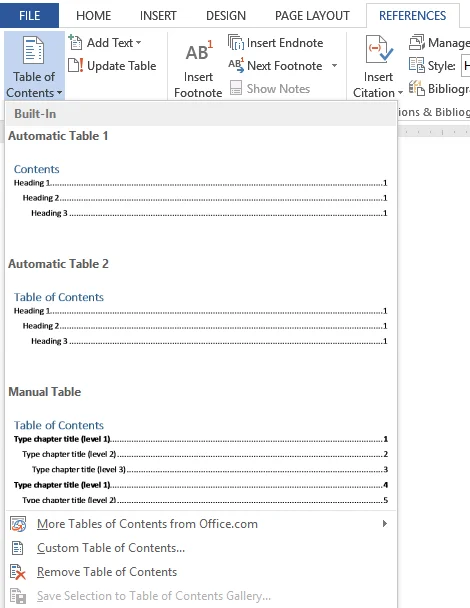
Updating the Table of Contents
As you proceed with editing your dissertation, the changes cause the page numbers and headings to vary. Often, people fail to incorporate those changes into the Table of Contents, which then effectively serves as an incorrect table and causes confusion.
It is thus important to update the changes into the table of contents as the final step once you have made all the necessary changes in the dissertation and are ready to print it.
These changes may alter the length of the thesis table of contents , which may also cause the dissertation’s formatting to be altered a little, so it is best to reformat it after updating the table of contents.
To update the table of contents,
- Select ‘Update Table’ in the References tab.
- This would open a dialogue box. Select ‘Update Entire Table’ to ensure that all changes are reflected in the contents table and not just the page numbers. This would display all changes and additions you have made to the document (Anon., 2017).
Using this guide, you should understand how to create the best table of contents for the dissertation. The use of a Table of Contents, while being important for most written work, is even more critical for dissertations, especially when the proper methodology of creating the table of contents is followed.
This includes the guidelines that must be considered to correctly format the table of contents so that it may be shaped so that it follows the norms and is effective at helping the reader navigate through the content of the dissertation.
The use of Microsoft Word’s Table of Contents generation feature has greatly helped people worldwide create, edit, and update the table of contents of their dissertations with ease.
Here in this article, we will uncover every piece of information you need to know how to write the dissertation’s abstract .
Are you in need of help with dissertation writing? At ResearchProspect, we have hundreds of Master’s and PhD qualified writers for all academic subjects, so you can get help with any aspect of your dissertation project. You can place your order for a proposal , full dissertation paper , or individual chapters .
Is it essential to add a table of content to the dissertation?
Yes, it is important to add a table of content in a dissertation .
How to make an effective table of contents for the dissertation?
Using heading styles to format your headings can save a lot of time by automatically converting their formatting to the defined style and serves as a tool to identify the heading and its level, used later when creating a thesis table of contents.
How do I update the table of contents?
You may also like.
The list of figures and tables in dissertation help the readers find tables and figures of their interest without looking through the whole dissertation.
Dissertation discussion is where you explore the relevance and significance of results. Here are guidelines to help you write the perfect discussion chapter.
USEFUL LINKS
LEARNING RESOURCES

COMPANY DETAILS

- How It Works
About Us arrow_drop_down expand_more
- News Releases
Our Values arrow_drop_down expand_more
- Diversity & Inclusion
- Accessibility
- Slavery Act Statement
Product Families arrow_drop_down expand_more

Content Solutions expand_more
- Books and Ebooks
- Dissertations
- News & Newspapers
- Primary Sources
- Streaming Video
Products by Subject expand_more
- Health & Medicine
- History & Social Change
- Interdisciplinary
- Science & Technology
- Social Sciences
Popular Products expand_more
Proquest one academic.
- ProQuest One Business
- ProQuest One Education
- ProQuest One Psychology
- ProQuest Black Studies
- Ebooks Offers for Libraries
Library Management expand_more
Discovery services expand_more, resource sharing expand_more, course resource lists expand_more, research management expand_more, mobile solutions expand_more.
- Innovative Mobile
Libraries We Serve expand_more
- Academic Solutions for universities, colleges, and community colleges of all sizes.
- Public Solutions for librarians supporting patrons of public libraries.
- K-12 Solutions for elementary schools, primary schools and high schools.
- Community College Solutions for community colleges, trade schools and two year programs.
- Government Solutions for governmental affairs offices, patent examiners, and grants administrators.
- Corporate Solutions for professionals in the pharmaceutical, legal industries and more.
Solutions For expand_more
- DEI E-Resources
- Print to Electronic
- Reclaiming Your Space
- Library Management
- Library Management – Public Libraries
- Community Engagement
- Content Discovery
- Research Repository
- Digital Preservation
- Resource Sharing
- Document Delivery
- Course Resources
Account Support expand_more
- Setup and Support
- Access Questions
- Renewing a Product
- Paying an Invoice
- Get Usage Data: ProQuest
- Get Usage Data: Alexander Street
- Submitting Dissertations
Idea Exchange
- ProQuest Status Page
Tools & Resources expand_more
- Find a Title List
- Accessibility Documentation
- Open Access
Browse Collections by Subject expand_more
I want to expand_more.
- Start my Research
- Start Text & Data Mining
- Find Research Funding
- Keep up with Research News
- Showcase Research
- See Upcoming Webinars
- Contact Support
I’m Interested In expand_more
- Submitting a Dissertation
- Purchasing a Dissertation
- Assembling Course Materials
- Implementing a Mobile Campus App
Insights expand_more
How text and data mining enables digital literacy in the classroom.
Read about the University of Sydney’s journey to integrate text and data mining (TDM) into its undergraduate courses and incorporate it across disciplines
Meeting Your Needs expand_more
- Graduate Students
- Graduate Administrators
Products & Services expand_more
- ETD Dissemination
- Dissertation & Theses Global
- ETD Dashboard
Resources expand_more
- eLearning Modules
- Expert Advice Articles

Dissertations News expand_more
- Top 25 Most-Accessed Dissertations
- Dissertations Award Winners
Are you a researcher looking for scholarly content? Try searching our platform here...
Language preference
Do you want set this as your default language ?
Connect with ProQuest
Dissertations & theses, proquest: the world leader in dissertation access and dissemination.
Over the last 80 years, ProQuest has built the world’s most comprehensive and renowned dissertations program. ProQuest Dissertations & Theses Global (PQDT Global), continues to grow its repository of 5 million graduate works each year, thanks to the continued contribution from the world’s universities, creating an ever-growing resource of emerging research to fuel innovation and new insights.
PQDT Global provides researchers with quality and equitable search results across all institutions, as well as rich citation data that delivers insights into the connections building around the world.

Amplify your Research
Include research with ProQuest to amplify its reach to a vast community of scholars. Submitting is free!

Accelerate your discovery
Subscribe to ProQuest Dissertations & Theses Global to accelerate and focus your discovery journey, resulting in more efficient and effective research.

Analyze your Influence
Analyze the influence and impact of your dissertations and theses globally by monitoring retrieval data from the ProQuest Platform.
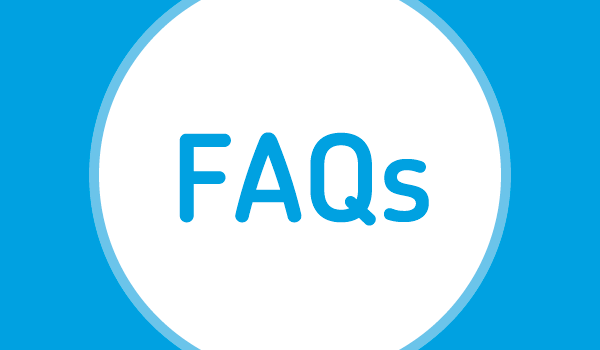
Have questions? We've gathered these frequently asked questions about ProQuest Dissertations & Theses.
Free online learning support to inspire and guide

ProQuest has developed on-demand instructional resources for students to use in a virtual learning environment. eLearning Companions are available to support the graduate student during their research and writing process as well as the undergraduate student who is developing their information literacy skills.
Access the Learning Modules
Spotlight on Research

Distinguished Dissertation and Thesis Award Winners
ProQuest sponsors our Graduate students and their ambitions. Click to see detailed author profiles and previous winners

Top 25 Dissertations
See what titles and topics are trending around the globe. Each month ProQuest posts the top 25 Most-Accessed Dissertations and Theses across all subjects, based upon total PDF downloads.

Have an idea for ProQuest? Share, vote and get feedback on ideas in our forums.
Subject Indexing Partners Enhancing Discoverability

Related Products

ProQuest Dissertation & Theses Global
ProQuest Dissertation & Theses Global is the world's most comprehensive curated collection of multi-disciplinary dissertations and theses from around the world.

Empower researchers to uncover new connections and make new discoveries using TDM Studio, a new solution for text and data mining (TDM). From the initial idea to the final output, TDM Studio puts the power of text and data mining directly in the researcher’s hands.

ProQuest One Academic brings together four core multi-disciplinary products, allowing access to the world’s largest curated collection of journals, ebooks, dissertations, news and video.

What Is Qualitative Content Analysis?
Qca explained simply (with examples).
By: Jenna Crosley (PhD). Reviewed by: Dr Eunice Rautenbach (DTech) | February 2021
If you’re in the process of preparing for your dissertation, thesis or research project, you’ve probably encountered the term “ qualitative content analysis ” – it’s quite a mouthful. If you’ve landed on this post, you’re probably a bit confused about it. Well, the good news is that you’ve come to the right place…
Overview: Qualitative Content Analysis
- What (exactly) is qualitative content analysis
- The two main types of content analysis
- When to use content analysis
- How to conduct content analysis (the process)
- The advantages and disadvantages of content analysis
1. What is content analysis?
Content analysis is a qualitative analysis method that focuses on recorded human artefacts such as manuscripts, voice recordings and journals. Content analysis investigates these written, spoken and visual artefacts without explicitly extracting data from participants – this is called unobtrusive research.
In other words, with content analysis, you don’t necessarily need to interact with participants (although you can if necessary); you can simply analyse the data that they have already produced. With this type of analysis, you can analyse data such as text messages, books, Facebook posts, videos, and audio (just to mention a few).
The basics – explicit and implicit content
When working with content analysis, explicit and implicit content will play a role. Explicit data is transparent and easy to identify, while implicit data is that which requires some form of interpretation and is often of a subjective nature. Sounds a bit fluffy? Here’s an example:
Joe: Hi there, what can I help you with?
Lauren: I recently adopted a puppy and I’m worried that I’m not feeding him the right food. Could you please advise me on what I should be feeding?
Joe: Sure, just follow me and I’ll show you. Do you have any other pets?
Lauren: Only one, and it tweets a lot!
In this exchange, the explicit data indicates that Joe is helping Lauren to find the right puppy food. Lauren asks Joe whether she has any pets aside from her puppy. This data is explicit because it requires no interpretation.
On the other hand, implicit data , in this case, includes the fact that the speakers are in a pet store. This information is not clearly stated but can be inferred from the conversation, where Joe is helping Lauren to choose pet food. An additional piece of implicit data is that Lauren likely has some type of bird as a pet. This can be inferred from the way that Lauren states that her pet “tweets”.
As you can see, explicit and implicit data both play a role in human interaction and are an important part of your analysis. However, it’s important to differentiate between these two types of data when you’re undertaking content analysis. Interpreting implicit data can be rather subjective as conclusions are based on the researcher’s interpretation. This can introduce an element of bias , which risks skewing your results.
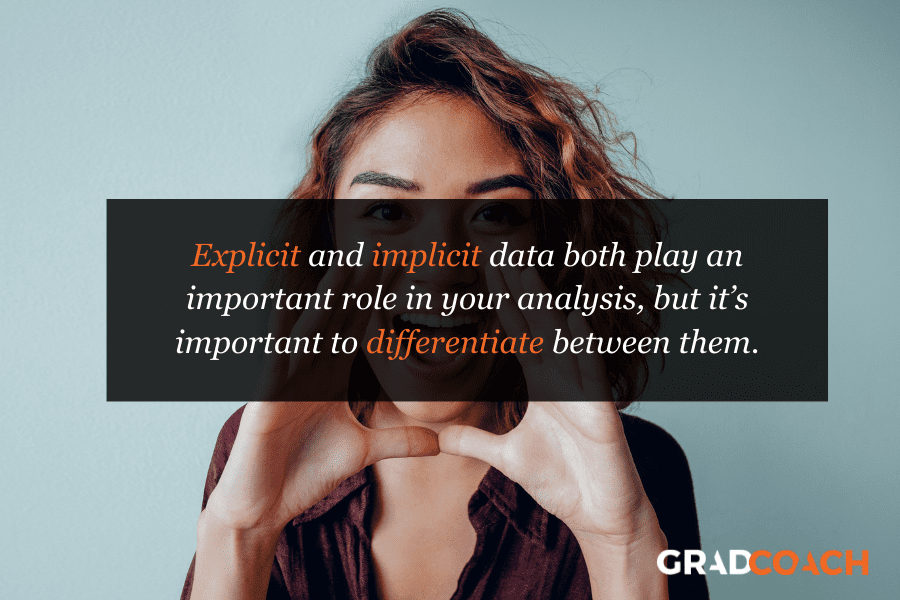
2. The two types of content analysis
Now that you understand the difference between implicit and explicit data, let’s move on to the two general types of content analysis : conceptual and relational content analysis. Importantly, while conceptual and relational content analysis both follow similar steps initially, the aims and outcomes of each are different.
Conceptual analysis focuses on the number of times a concept occurs in a set of data and is generally focused on explicit data. For example, if you were to have the following conversation:
Marie: She told me that she has three cats.
Jean: What are her cats’ names?
Marie: I think the first one is Bella, the second one is Mia, and… I can’t remember the third cat’s name.
In this data, you can see that the word “cat” has been used three times. Through conceptual content analysis, you can deduce that cats are the central topic of the conversation. You can also perform a frequency analysis , where you assess the term’s frequency in the data. For example, in the exchange above, the word “cat” makes up 9% of the data. In other words, conceptual analysis brings a little bit of quantitative analysis into your qualitative analysis.
As you can see, the above data is without interpretation and focuses on explicit data . Relational content analysis, on the other hand, takes a more holistic view by focusing more on implicit data in terms of context, surrounding words and relationships.
There are three types of relational analysis:
- Affect extraction
- Proximity analysis
- Cognitive mapping
Affect extraction is when you assess concepts according to emotional attributes. These emotions are typically mapped on scales, such as a Likert scale or a rating scale ranging from 1 to 5, where 1 is “very sad” and 5 is “very happy”.
If participants are talking about their achievements, they are likely to be given a score of 4 or 5, depending on how good they feel about it. If a participant is describing a traumatic event, they are likely to have a much lower score, either 1 or 2.
Proximity analysis identifies explicit terms (such as those found in a conceptual analysis) and the patterns in terms of how they co-occur in a text. In other words, proximity analysis investigates the relationship between terms and aims to group these to extract themes and develop meaning.
Proximity analysis is typically utilised when you’re looking for hard facts rather than emotional, cultural, or contextual factors. For example, if you were to analyse a political speech, you may want to focus only on what has been said, rather than implications or hidden meanings. To do this, you would make use of explicit data, discounting any underlying meanings and implications of the speech.
Lastly, there’s cognitive mapping, which can be used in addition to, or along with, proximity analysis. Cognitive mapping involves taking different texts and comparing them in a visual format – i.e. a cognitive map. Typically, you’d use cognitive mapping in studies that assess changes in terms, definitions, and meanings over time. It can also serve as a way to visualise affect extraction or proximity analysis and is often presented in a form such as a graphic map.
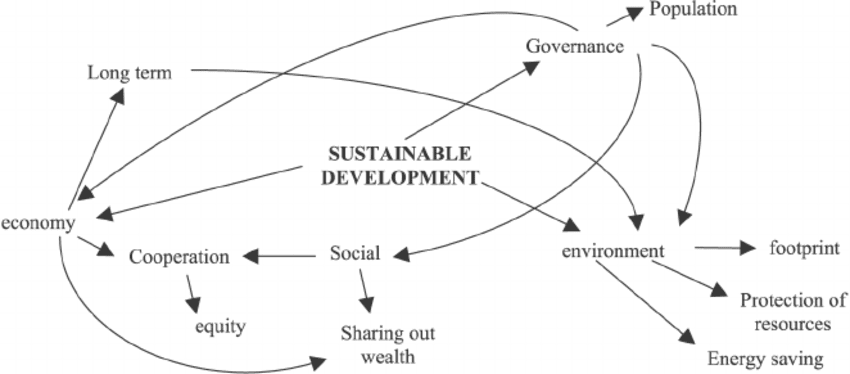
To recap on the essentials, content analysis is a qualitative analysis method that focuses on recorded human artefacts . It involves both conceptual analysis (which is more numbers-based) and relational analysis (which focuses on the relationships between concepts and how they’re connected).
Need a helping hand?
3. When should you use content analysis?
Content analysis is a useful tool that provides insight into trends of communication . For example, you could use a discussion forum as the basis of your analysis and look at the types of things the members talk about as well as how they use language to express themselves. Content analysis is flexible in that it can be applied to the individual, group, and institutional level.
Content analysis is typically used in studies where the aim is to better understand factors such as behaviours, attitudes, values, emotions, and opinions . For example, you could use content analysis to investigate an issue in society, such as miscommunication between cultures. In this example, you could compare patterns of communication in participants from different cultures, which will allow you to create strategies for avoiding misunderstandings in intercultural interactions.
Another example could include conducting content analysis on a publication such as a book. Here you could gather data on the themes, topics, language use and opinions reflected in the text to draw conclusions regarding the political (such as conservative or liberal) leanings of the publication.
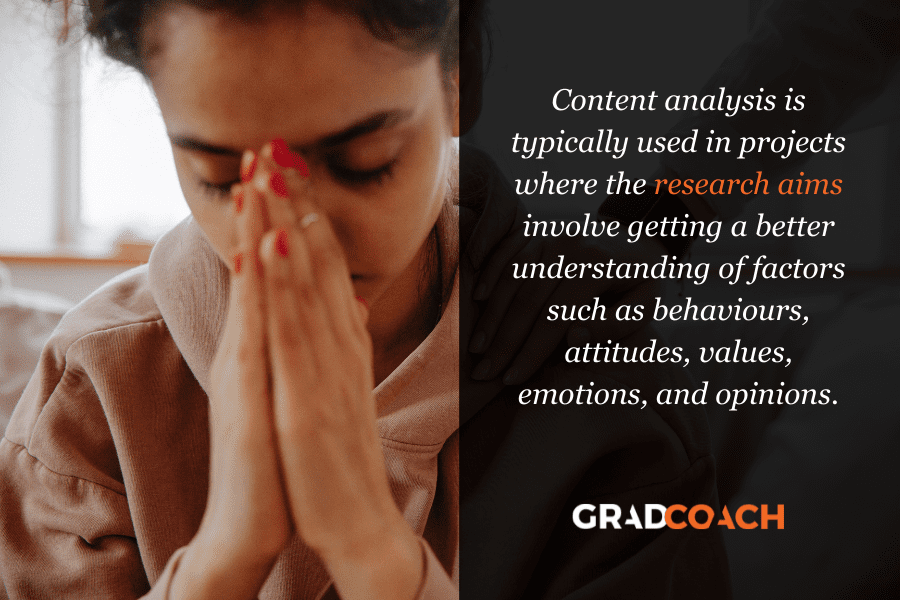
4. How to conduct a qualitative content analysis
Conceptual and relational content analysis differ in terms of their exact process ; however, there are some similarities. Let’s have a look at these first – i.e., the generic process:
- Recap on your research questions
- Undertake bracketing to identify biases
- Operationalise your variables and develop a coding scheme
- Code the data and undertake your analysis
Step 1 – Recap on your research questions
It’s always useful to begin a project with research questions , or at least with an idea of what you are looking for. In fact, if you’ve spent time reading this blog, you’ll know that it’s useful to recap on your research questions, aims and objectives when undertaking pretty much any research activity. In the context of content analysis, it’s difficult to know what needs to be coded and what doesn’t, without a clear view of the research questions.
For example, if you were to code a conversation focused on basic issues of social justice, you may be met with a wide range of topics that may be irrelevant to your research. However, if you approach this data set with the specific intent of investigating opinions on gender issues, you will be able to focus on this topic alone, which would allow you to code only what you need to investigate.
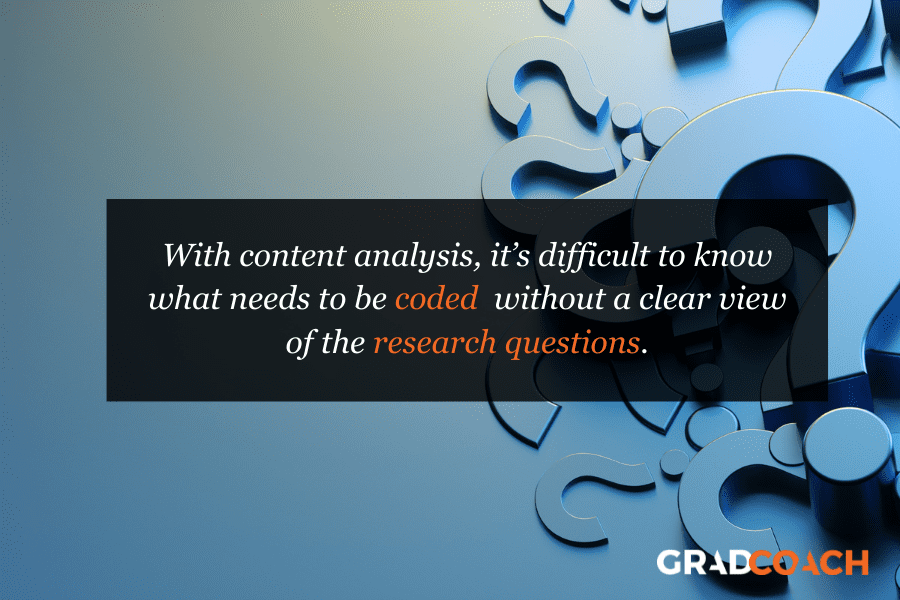
Step 2 – Reflect on your personal perspectives and biases
It’s vital that you reflect on your own pre-conception of the topic at hand and identify the biases that you might drag into your content analysis – this is called “ bracketing “. By identifying this upfront, you’ll be more aware of them and less likely to have them subconsciously influence your analysis.
For example, if you were to investigate how a community converses about unequal access to healthcare, it is important to assess your views to ensure that you don’t project these onto your understanding of the opinions put forth by the community. If you have access to medical aid, for instance, you should not allow this to interfere with your examination of unequal access.
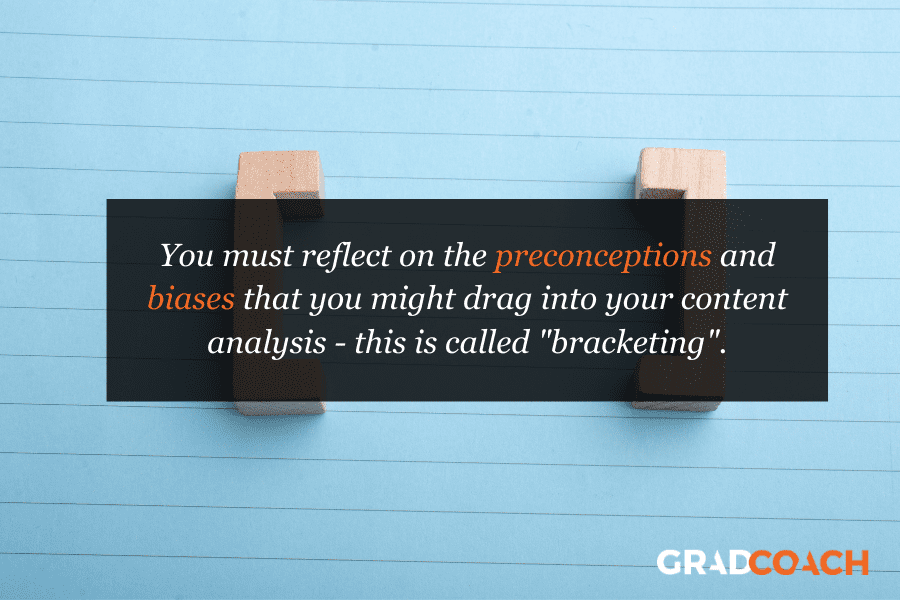
Step 3 – Operationalise your variables and develop a coding scheme
Next, you need to operationalise your variables . But what does that mean? Simply put, it means that you have to define each variable or construct . Give every item a clear definition – what does it mean (include) and what does it not mean (exclude). For example, if you were to investigate children’s views on healthy foods, you would first need to define what age group/range you’re looking at, and then also define what you mean by “healthy foods”.
In combination with the above, it is important to create a coding scheme , which will consist of information about your variables (how you defined each variable), as well as a process for analysing the data. For this, you would refer back to how you operationalised/defined your variables so that you know how to code your data.
For example, when coding, when should you code a food as “healthy”? What makes a food choice healthy? Is it the absence of sugar or saturated fat? Is it the presence of fibre and protein? It’s very important to have clearly defined variables to achieve consistent coding – without this, your analysis will get very muddy, very quickly.

Step 4 – Code and analyse the data
The next step is to code the data. At this stage, there are some differences between conceptual and relational analysis.
As described earlier in this post, conceptual analysis looks at the existence and frequency of concepts, whereas a relational analysis looks at the relationships between concepts. For both types of analyses, it is important to pre-select a concept that you wish to assess in your data. Using the example of studying children’s views on healthy food, you could pre-select the concept of “healthy food” and assess the number of times the concept pops up in your data.
Here is where conceptual and relational analysis start to differ.
At this stage of conceptual analysis , it is necessary to decide on the level of analysis you’ll perform on your data, and whether this will exist on the word, phrase, sentence, or thematic level. For example, will you code the phrase “healthy food” on its own? Will you code each term relating to healthy food (e.g., broccoli, peaches, bananas, etc.) with the code “healthy food” or will these be coded individually? It is very important to establish this from the get-go to avoid inconsistencies that could result in you having to code your data all over again.
On the other hand, relational analysis looks at the type of analysis. So, will you use affect extraction? Proximity analysis? Cognitive mapping? A mix? It’s vital to determine the type of analysis before you begin to code your data so that you can maintain the reliability and validity of your research .

How to conduct conceptual analysis
First, let’s have a look at the process for conceptual analysis.
Once you’ve decided on your level of analysis, you need to establish how you will code your concepts, and how many of these you want to code. Here you can choose whether you want to code in a deductive or inductive manner. Just to recap, deductive coding is when you begin the coding process with a set of pre-determined codes, whereas inductive coding entails the codes emerging as you progress with the coding process. Here it is also important to decide what should be included and excluded from your analysis, and also what levels of implication you wish to include in your codes.
For example, if you have the concept of “tall”, can you include “up in the clouds”, derived from the sentence, “the giraffe’s head is up in the clouds” in the code, or should it be a separate code? In addition to this, you need to know what levels of words may be included in your codes or not. For example, if you say, “the panda is cute” and “look at the panda’s cuteness”, can “cute” and “cuteness” be included under the same code?
Once you’ve considered the above, it’s time to code the text . We’ve already published a detailed post about coding , so we won’t go into that process here. Once you’re done coding, you can move on to analysing your results. This is where you will aim to find generalisations in your data, and thus draw your conclusions .
How to conduct relational analysis
Now let’s return to relational analysis.
As mentioned, you want to look at the relationships between concepts . To do this, you’ll need to create categories by reducing your data (in other words, grouping similar concepts together) and then also code for words and/or patterns. These are both done with the aim of discovering whether these words exist, and if they do, what they mean.
Your next step is to assess your data and to code the relationships between your terms and meanings, so that you can move on to your final step, which is to sum up and analyse the data.
To recap, it’s important to start your analysis process by reviewing your research questions and identifying your biases . From there, you need to operationalise your variables, code your data and then analyse it.
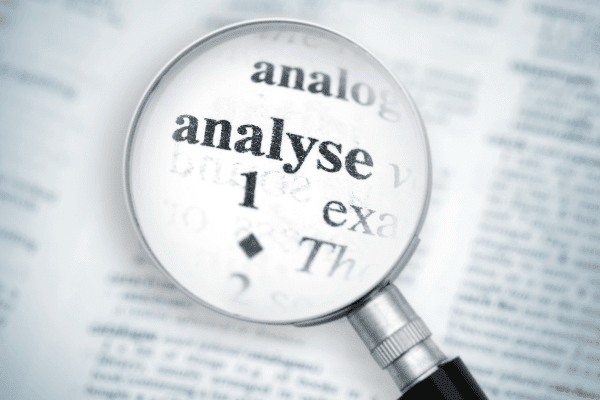
5. What are the pros & cons of content analysis?
One of the main advantages of content analysis is that it allows you to use a mix of quantitative and qualitative research methods, which results in a more scientifically rigorous analysis.
For example, with conceptual analysis, you can count the number of times that a term or a code appears in a dataset, which can be assessed from a quantitative standpoint. In addition to this, you can then use a qualitative approach to investigate the underlying meanings of these and relationships between them.
Content analysis is also unobtrusive and therefore poses fewer ethical issues than some other analysis methods. As the content you’ll analyse oftentimes already exists, you’ll analyse what has been produced previously, and so you won’t have to collect data directly from participants. When coded correctly, data is analysed in a very systematic and transparent manner, which means that issues of replicability (how possible it is to recreate research under the same conditions) are reduced greatly.
On the downside , qualitative research (in general, not just content analysis) is often critiqued for being too subjective and for not being scientifically rigorous enough. This is where reliability (how replicable a study is by other researchers) and validity (how suitable the research design is for the topic being investigated) come into play – if you take these into account, you’ll be on your way to achieving sound research results.

Recap: Qualitative content analysis
In this post, we’ve covered a lot of ground – click on any of the sections to recap:
If you have any questions about qualitative content analysis, feel free to leave a comment below. If you’d like 1-on-1 help with your qualitative content analysis, be sure to book an initial consultation with one of our friendly Research Coaches.

Psst... there’s more!
This post was based on one of our popular Research Bootcamps . If you're working on a research project, you'll definitely want to check this out ...
19 Comments
If I am having three pre-decided attributes for my research based on which a set of semi-structured questions where asked then should I conduct a conceptual content analysis or relational content analysis. please note that all three attributes are different like Agility, Resilience and AI.
Thank you very much. I really enjoyed every word.
please send me one/ two sample of content analysis
send me to any sample of qualitative content analysis as soon as possible
Many thanks for the brilliant explanation. Do you have a sample practical study of a foreign policy using content analysis?
1) It will be very much useful if a small but complete content analysis can be sent, from research question to coding and analysis. 2) Is there any software by which qualitative content analysis can be done?
Common software for qualitative analysis is nVivo, and quantitative analysis is IBM SPSS
Thank you. Can I have at least 2 copies of a sample analysis study as my reference?
Could you please send me some sample of textbook content analysis?
Can I send you my research topic, aims, objectives and questions to give me feedback on them?
please could you send me samples of content analysis?
Yes please send
really we enjoyed your knowledge thanks allot. from Ethiopia
can you please share some samples of content analysis(relational)? I am a bit confused about processing the analysis part
Is it possible for you to list the journal articles and books or other sources you used to write this article? Thank you.
can you please send some samples of content analysis ?
can you kindly send some good examples done by using content analysis ?
This was very useful. can you please send me sample for qualitative content analysis. thank you
What a brilliant explanation! Kindly help with textbooks or blogs on the context analysis method such as discourse, thematic and semiotic analysis.
Submit a Comment Cancel reply
Your email address will not be published. Required fields are marked *
Save my name, email, and website in this browser for the next time I comment.
- Print Friendly
The Institutional Repository for the University of Houston-Clear Lake
HawkWorks is a digital service provided by the UHCL Libraries that preserves and provides access to the scholarship and creative works produced and owned by the University of Houston-Clear Lake community.
Communities in HawkWorks
Select a community to browse its collections.
- Colleges An open-access digital archive for the scholarly output of UHCL four colleges (Business, Education, Humans Sciences and Humanities, and Science and Engineering), including theses and dissertations.
- Digitized Theses and Dissertations (1974 - 2015) Digitized collection of historical theses, dissertations, and graduate projects created by University of Houston-Clear Lake graduates
- Electronic Theses and Dissertations (Fall 2015 - Present) A collection of electronic theses, dissertations, and graduate projects created by University of Houston-Clear Lake graduates
- UHCL Archives and Special Collections Materials and finding aids from the University of Houston-Clear Lake Archives and Special Collections' three collecting areas and the Johnson Space Center History Collection.
- UHCL Faculty Works (Abstracts Only)
- UHCL Faculty, Staff, and Student Works Collection of scholarly output from UHCL faculty, staff, and students, including academic publications, working papers, technical reports, & white papers, and conference papers, posters, & presentations
Recent Submissions
Have a language expert improve your writing
Run a free plagiarism check in 10 minutes, generate accurate citations for free.
- Knowledge Base
- Dissertation
- What Is a Thesis? | Ultimate Guide & Examples
What Is a Thesis? | Ultimate Guide & Examples
Published on September 14, 2022 by Tegan George . Revised on April 16, 2024.
A thesis is a type of research paper based on your original research. It is usually submitted as the final step of a master’s program or a capstone to a bachelor’s degree.
Writing a thesis can be a daunting experience. Other than a dissertation , it is one of the longest pieces of writing students typically complete. It relies on your ability to conduct research from start to finish: choosing a relevant topic , crafting a proposal , designing your research , collecting data , developing a robust analysis, drawing strong conclusions , and writing concisely .
Thesis template
You can also download our full thesis template in the format of your choice below. Our template includes a ready-made table of contents , as well as guidance for what each chapter should include. It’s easy to make it your own, and can help you get started.
Download Word template Download Google Docs template
Instantly correct all language mistakes in your text
Upload your document to correct all your mistakes in minutes

Table of contents
Thesis vs. thesis statement, how to structure a thesis, acknowledgements or preface, list of figures and tables, list of abbreviations, introduction, literature review, methodology, reference list, proofreading and editing, defending your thesis, other interesting articles, frequently asked questions about theses.
You may have heard the word thesis as a standalone term or as a component of academic writing called a thesis statement . Keep in mind that these are two very different things.
- A thesis statement is a very common component of an essay, particularly in the humanities. It usually comprises 1 or 2 sentences in the introduction of your essay , and should clearly and concisely summarize the central points of your academic essay .
- A thesis is a long-form piece of academic writing, often taking more than a full semester to complete. It is generally a degree requirement for Master’s programs, and is also sometimes required to complete a bachelor’s degree in liberal arts colleges.
- In the US, a dissertation is generally written as a final step toward obtaining a PhD.
- In other countries (particularly the UK), a dissertation is generally written at the bachelor’s or master’s level.
Prevent plagiarism. Run a free check.
The final structure of your thesis depends on a variety of components, such as:
- Your discipline
- Your theoretical approach
Humanities theses are often structured more like a longer-form essay . Just like in an essay, you build an argument to support a central thesis.
In both hard and social sciences, theses typically include an introduction , literature review , methodology section , results section , discussion section , and conclusion section . These are each presented in their own dedicated section or chapter. In some cases, you might want to add an appendix .
Thesis examples
We’ve compiled a short list of thesis examples to help you get started.
- Example thesis #1: “Abolition, Africans, and Abstraction: the Influence of the ‘Noble Savage’ on British and French Antislavery Thought, 1787-1807” by Suchait Kahlon.
- Example thesis #2: “’A Starving Man Helping Another Starving Man’: UNRRA, India, and the Genesis of Global Relief, 1943-1947″ by Julian Saint Reiman.
The very first page of your thesis contains all necessary identifying information, including:
- Your full title
- Your full name
- Your department
- Your institution and degree program
- Your submission date.
Sometimes the title page also includes your student ID, the name of your supervisor, or the university’s logo. Check out your university’s guidelines if you’re not sure.
Read more about title pages
The acknowledgements section is usually optional. Its main point is to allow you to thank everyone who helped you in your thesis journey, such as supervisors, friends, or family. You can also choose to write a preface , but it’s typically one or the other, not both.
Read more about acknowledgements Read more about prefaces
Here's why students love Scribbr's proofreading services
Discover proofreading & editing
An abstract is a short summary of your thesis. Usually a maximum of 300 words long, it’s should include brief descriptions of your research objectives , methods, results, and conclusions. Though it may seem short, it introduces your work to your audience, serving as a first impression of your thesis.
Read more about abstracts
A table of contents lists all of your sections, plus their corresponding page numbers and subheadings if you have them. This helps your reader seamlessly navigate your document.
Your table of contents should include all the major parts of your thesis. In particular, don’t forget the the appendices. If you used heading styles, it’s easy to generate an automatic table Microsoft Word.
Read more about tables of contents
While not mandatory, if you used a lot of tables and/or figures, it’s nice to include a list of them to help guide your reader. It’s also easy to generate one of these in Word: just use the “Insert Caption” feature.
Read more about lists of figures and tables
If you have used a lot of industry- or field-specific abbreviations in your thesis, you should include them in an alphabetized list of abbreviations . This way, your readers can easily look up any meanings they aren’t familiar with.
Read more about lists of abbreviations
Relatedly, if you find yourself using a lot of very specialized or field-specific terms that may not be familiar to your reader, consider including a glossary . Alphabetize the terms you want to include with a brief definition.
Read more about glossaries
An introduction sets up the topic, purpose, and relevance of your thesis, as well as expectations for your reader. This should:
- Ground your research topic , sharing any background information your reader may need
- Define the scope of your work
- Introduce any existing research on your topic, situating your work within a broader problem or debate
- State your research question(s)
- Outline (briefly) how the remainder of your work will proceed
In other words, your introduction should clearly and concisely show your reader the “what, why, and how” of your research.
Read more about introductions
A literature review helps you gain a robust understanding of any extant academic work on your topic, encompassing:
- Selecting relevant sources
- Determining the credibility of your sources
- Critically evaluating each of your sources
- Drawing connections between sources, including any themes, patterns, conflicts, or gaps
A literature review is not merely a summary of existing work. Rather, your literature review should ultimately lead to a clear justification for your own research, perhaps via:
- Addressing a gap in the literature
- Building on existing knowledge to draw new conclusions
- Exploring a new theoretical or methodological approach
- Introducing a new solution to an unresolved problem
- Definitively advocating for one side of a theoretical debate
Read more about literature reviews
Theoretical framework
Your literature review can often form the basis for your theoretical framework, but these are not the same thing. A theoretical framework defines and analyzes the concepts and theories that your research hinges on.
Read more about theoretical frameworks
Your methodology chapter shows your reader how you conducted your research. It should be written clearly and methodically, easily allowing your reader to critically assess the credibility of your argument. Furthermore, your methods section should convince your reader that your method was the best way to answer your research question.
A methodology section should generally include:
- Your overall approach ( quantitative vs. qualitative )
- Your research methods (e.g., a longitudinal study )
- Your data collection methods (e.g., interviews or a controlled experiment
- Any tools or materials you used (e.g., computer software)
- The data analysis methods you chose (e.g., statistical analysis , discourse analysis )
- A strong, but not defensive justification of your methods
Read more about methodology sections
Your results section should highlight what your methodology discovered. These two sections work in tandem, but shouldn’t repeat each other. While your results section can include hypotheses or themes, don’t include any speculation or new arguments here.
Your results section should:
- State each (relevant) result with any (relevant) descriptive statistics (e.g., mean , standard deviation ) and inferential statistics (e.g., test statistics , p values )
- Explain how each result relates to the research question
- Determine whether the hypothesis was supported
Additional data (like raw numbers or interview transcripts ) can be included as an appendix . You can include tables and figures, but only if they help the reader better understand your results.
Read more about results sections
Your discussion section is where you can interpret your results in detail. Did they meet your expectations? How well do they fit within the framework that you built? You can refer back to any relevant source material to situate your results within your field, but leave most of that analysis in your literature review.
For any unexpected results, offer explanations or alternative interpretations of your data.
Read more about discussion sections
Your thesis conclusion should concisely answer your main research question. It should leave your reader with an ultra-clear understanding of your central argument, and emphasize what your research specifically has contributed to your field.
Why does your research matter? What recommendations for future research do you have? Lastly, wrap up your work with any concluding remarks.
Read more about conclusions
In order to avoid plagiarism , don’t forget to include a full reference list at the end of your thesis, citing the sources that you used. Choose one citation style and follow it consistently throughout your thesis, taking note of the formatting requirements of each style.
Which style you choose is often set by your department or your field, but common styles include MLA , Chicago , and APA.
Create APA citations Create MLA citations
In order to stay clear and concise, your thesis should include the most essential information needed to answer your research question. However, chances are you have many contributing documents, like interview transcripts or survey questions . These can be added as appendices , to save space in the main body.
Read more about appendices
Once you’re done writing, the next part of your editing process begins. Leave plenty of time for proofreading and editing prior to submission. Nothing looks worse than grammar mistakes or sloppy spelling errors!
Consider using a professional thesis editing service or grammar checker to make sure your final project is perfect.
Once you’ve submitted your final product, it’s common practice to have a thesis defense, an oral component of your finished work. This is scheduled by your advisor or committee, and usually entails a presentation and Q&A session.
After your defense , your committee will meet to determine if you deserve any departmental honors or accolades. However, keep in mind that defenses are usually just a formality. If there are any serious issues with your work, these should be resolved with your advisor way before a defense.
If you want to know more about AI for academic writing, AI tools, or research bias, make sure to check out some of our other articles with explanations and examples or go directly to our tools!
Research bias
- Survivorship bias
- Self-serving bias
- Availability heuristic
- Halo effect
- Hindsight bias
- Deep learning
- Generative AI
- Machine learning
- Reinforcement learning
- Supervised vs. unsupervised learning
(AI) Tools
- Grammar Checker
- Paraphrasing Tool
- Text Summarizer
- AI Detector
- Plagiarism Checker
- Citation Generator
The conclusion of your thesis or dissertation shouldn’t take up more than 5–7% of your overall word count.
If you only used a few abbreviations in your thesis or dissertation , you don’t necessarily need to include a list of abbreviations .
If your abbreviations are numerous, or if you think they won’t be known to your audience, it’s never a bad idea to add one. They can also improve readability, minimizing confusion about abbreviations unfamiliar to your reader.
When you mention different chapters within your text, it’s considered best to use Roman numerals for most citation styles. However, the most important thing here is to remain consistent whenever using numbers in your dissertation .
A thesis or dissertation outline is one of the most critical first steps in your writing process. It helps you to lay out and organize your ideas and can provide you with a roadmap for deciding what kind of research you’d like to undertake.
Generally, an outline contains information on the different sections included in your thesis or dissertation , such as:
- Your anticipated title
- Your abstract
- Your chapters (sometimes subdivided into further topics like literature review , research methods , avenues for future research, etc.)
A thesis is typically written by students finishing up a bachelor’s or Master’s degree. Some educational institutions, particularly in the liberal arts, have mandatory theses, but they are often not mandatory to graduate from bachelor’s degrees. It is more common for a thesis to be a graduation requirement from a Master’s degree.
Even if not mandatory, you may want to consider writing a thesis if you:
- Plan to attend graduate school soon
- Have a particular topic you’d like to study more in-depth
- Are considering a career in research
- Would like a capstone experience to tie up your academic experience
Cite this Scribbr article
If you want to cite this source, you can copy and paste the citation or click the “Cite this Scribbr article” button to automatically add the citation to our free Citation Generator.
George, T. (2024, April 16). What Is a Thesis? | Ultimate Guide & Examples. Scribbr. Retrieved September 9, 2024, from https://www.scribbr.com/dissertation/thesis/
Is this article helpful?
Tegan George
Other students also liked, dissertation & thesis outline | example & free templates, writing strong research questions | criteria & examples, 10 research question examples to guide your research project, "i thought ai proofreading was useless but..".
I've been using Scribbr for years now and I know it's a service that won't disappoint. It does a good job spotting mistakes”
An official website of the United States government
Here's how you know
Official websites use .gov A .gov website belongs to an official government organization in the United States.
Secure .gov websites use HTTPS. A lock ( Lock Locked padlock ) or https:// means you've safely connected to the .gov website. Share sensitive information only on official, secure websites.

Cultural Anthropology Program - Doctoral Dissertation Research Improvement Grants (CA-DDRIG)
View guidelines, important information about nsf’s implementation of the revised 2 cfr.
NSF Financial Assistance awards (grants and cooperative agreements) made on or after October 1, 2024, will be subject to the applicable set of award conditions, dated October 1, 2024, available on the NSF website . These terms and conditions are consistent with the revised guidance specified in the OMB Guidance for Federal Financial Assistance published in the Federal Register on April 22, 2024.
Important information for proposers
All proposals must be submitted in accordance with the requirements specified in this funding opportunity and in the NSF Proposal & Award Policies & Procedures Guide (PAPPG) that is in effect for the relevant due date to which the proposal is being submitted. It is the responsibility of the proposer to ensure that the proposal meets these requirements. Submitting a proposal prior to a specified deadline does not negate this requirement.
Supports doctoral research aimed at understanding patterns, causes and consequences of human social and cultural variation, including research that has implications for confronting anthropogenic problems.
The primary objective of the Cultural Anthropology Program is to support basic scientific research on the causes, consequences and complexities of human social and cultural variability.
Contemporary cultural anthropology is an arena in which diverse research traditions and methodologies are valid in investigations of human cultural variation. Recognizing the breadth of the field's contributions to science, the Cultural Anthropology Program welcomes proposals for empirically grounded, theoretically engaged and methodologically sophisticated research in all sub-fields of cultural anthropology. Because the National Science Foundation's mission is to support basic research, the NSF Cultural Anthropology Program does not fund research that takes as its primary goal improved clinical practice, humanistic understanding or applied policy. A proposal that applies anthropological methods to a social problem but does not propose how that problem provides an opportunity to make a theory-testing and/or theory-expanding contribution to anthropology will be returned without review.
Program research priorities include, but are not limited to, research that increases our understanding of:
- Sociocultural drivers of critical anthropogenic processes such as deforestation, desertification, land cover change, urbanization and poverty.
- Resilience and robustness of sociocultural systems.
- Scientific principles underlying conflict, cooperation and altruism, as well as explanations of variation in culture, norms, behaviors and institutions.
- Economy, culture, migration and globalization.
- Variability and change in kinship and family norms and practices.
- General cultural and social principles underlining the drivers of health outcomes and disease transmission.
- Biocultural work that considers the nexus of human culture and its relationship with human biology.
- Social regulation, governmentality and violence.
- Origins of complexity in sociocultural systems.
- Language and culture: orality and literacy, sociolinguistics and cognition.
- Theoretically-informed approaches to co-production in relation to scientific understandings of human variability and environmental stewardship.
- Mathematical and computational models of sociocultural systems such as social network analysis, agent-based models, multi-level models, and modes that integrate agent-based simulations and geographic information systems (GIS).
As part of its effort to encourage and support projects that explicitly integrate education and basic research, CA provides support to enhance and improve the conduct of doctoral dissertation projects designed and carried out by doctoral students enrolled in U.S. institutions of higher education who are conducting scientific research that enhances basic scientific knowledge.
Updates and announcements
Video and slides from cultural anthropology funding opportunity webinars, may and july, 2022, program contacts.
| (703) 292-7783 | SBE/BCS | ||
| Program Director | (703) 292-8740 | SBE/BCS | |
| Program Director | (703) 292-8740 | SBE/BCS | |
| Program Specialist | (703) 292-4636 | SBE/BCS |
Additional program resources
- AAA Statement on Protecting and Preserving Field Records and Related Links
- Sample successful CA-DDRIG proposal
Awards made through this program
Related programs.
- Cultural Anthropology Program Senior Research Awards (CA-SR)
Organization(s)
- Directorate for Social, Behavioral and Economic Sciences (SBE)
- Division of Behavioral and Cognitive Sciences (SBE/BCS)

IMAGES
VIDEO
COMMENTS
How To Write A Dissertation Or Thesis (+ Examples)
Dissertation Content . A doctoral dissertation makes an original contribution to knowledge, as defined in a discipline or an interdisciplinary domain and addresses a significant researchable problem. Not all problems are researchable and not all are significant. Problems that can be solved by a mere descriptive exercise are not appropriate for ...
What Is a Dissertation? | Guide, Examples, & Template
Dissertation Table of Contents in Word | Instructions & ...
How to Write a Dissertation | A Guide to Structure & Content
The Complete Guide to Writing a Dissertation
Dissertation Table of Contents in Word | Instructions & Examples. Published on 15 May 2022 by Tegan George. The table of contents is where you list the chapters and major sections of your thesis, dissertation, or research paper, alongside their page numbers. A clear and well-formatted table of contents is essential, as it demonstrates to your reader that a quality paper will follow.
Dissertation Structure & Layout 101 (+ Examples)
All level 1 and 2 headings should be included in your table of contents. That means the titles of your chapters and the main sections within them. The contents should also include all appendices and the lists of tables and figures, if applicable, as well as your reference list. Do not include the acknowledgements or abstract in the table of ...
How to Write a Dissertation: Step-by-Step Guide
Dissertation Content When the content of the dissertation starts, the page numbering should restart at page one using Arabic numbering (i.e., 1, 2, 3, etc.) and continue throughout the dissertation until the end. The Arabic page number should be aligned to the upper right margin of the page with a running head aligned to the upper left margin.
The dissertation is a requirement of the Ph.D. degree. Formatting Requirement and Standards. The Graduate School sets the minimum format for your thesis or dissertation, while you, your special committee, and your advisor/chair decide upon the content and length. Grammar, punctuation, spelling, and other mechanical issues are your sole ...
What Is a Dissertation? | 5 Essential Questions to Get Started
How To Write A Dissertation Introduction Chapter
How to Write a Dissertation or Thesis Proposal
Generating Dissertation Table of Contents. First, to generate the Table of Contents, start by entering a blank page after the pages you need the table of contents to follow. To do so, click on the bottom of the page you want before the Table of Contents. Open the 'Insert' tab and select 'Page Break'.
The Dissertation: Chapter Breakdown - Writer's Exchange
Sample Dissertation Overview. The problem generally is addressed in two related parts: The problem statement is contained in Chapter 1, and a review of the related research, theory, and professional literature is described in Chapter 2. The methods used for investigating the problem are usually included in Chapter 3.
Dissertations & Theses - ProQuest ... Dissertations
Qualitative Content Analysis 101 (+ Examples)
The Dissertation
How to Write a Thesis or Dissertation Introduction
A collection of electronic theses, dissertations, and graduate projects created by University of Houston-Clear Lake graduates UHCL Archives and Special Collections Materials and finding aids from the University of Houston-Clear Lake Archives and Special Collections' three collecting areas and the Johnson Space Center History Collection.
What Is a Thesis? | Ultimate Guide & Examples
As part of its effort to encourage and support projects that explicitly integrate education and basic research, CA provides support to enhance and improve the conduct of doctoral dissertation projects designed and carried out by doctoral students enrolled in U.S. institutions of higher education who are conducting scientific research that ...